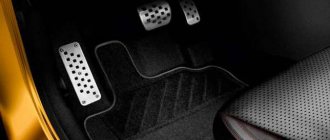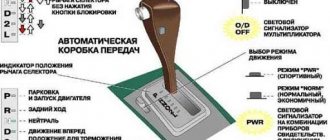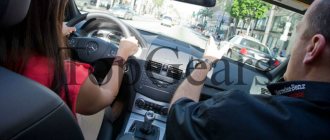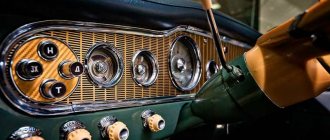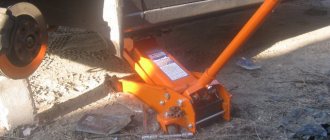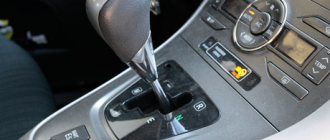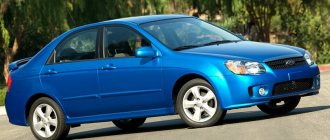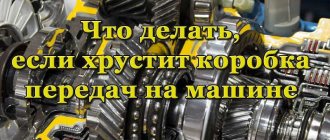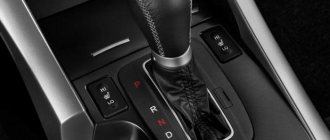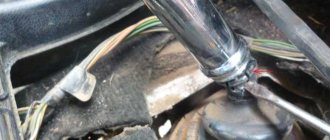Brake pedal
Since a car equipped with an automatic transmission does not have a clutch pedal (it turns on automatically when the required engine torque is reached), movement begins after the brake pedal is released.
Factory engine settings allow you to start moving even without pressing the gas pedal after releasing the brake pedal. Gas is added to move to a higher transmission stage.
Brake pedal
The brake pedal also regulates the speed limit when driving on roads during coasting descents from hills. In position P (parking), the hand brake does not need to be applied, since the wheel drive is in rigid coupling with the gears of the automatic transmission, and a very large external force is required for the car to move.
The location of the pedals in the car
First you need to decide what kind of gearbox cars come with.
There are two types:
- with manual transmission,
- with automatic gear shift mechanism.
The tasks of both devices are similar - changing gears. But in the first case this is done by the driver, and in the second it happens without the participation of the driver. What does this have to do with such a control as pedals? The most direct. Depending on the gearbox installed in the car, there may be three or two.
So, in the case of a mechanical gear selector, there will be three pedals. In the case of an automatic transmission - two. The pedal assembly is located on the left at foot level under the instrument panel and steering wheel.
The manual transmission comes with the following pedals:
- Clutch (located on the far left).
- Brakes (located between the clutch pedal and the gas (accelerator) pedal.
- Gaza (which is located on the far right).
With an automatic transmission the following pedals are located:
- Accelerator (located on the far right).
- Brakes (located to the left of the gas pedal).
It is important to remember that traditionally the brake pedal is located a little closer to the driver and appears to be protruding. The gas pedal is opposite, always slightly recessed towards the engine compartment. This was done for the intuitive convenience of perceiving their location.
In a car with a manual transmission, the brake and gas pedals are located to the right of the steering column, and the clutch pedal is to the left of it. At the same time, in a car with an automatic transmission, the brake and gas pedal are located to the right of the steering column, as in a car with a manual transmission.
In place of the clutch pedal there is a footrest. As a design feature, some vehicles intended for sale in the North American market may have a parking brake pedal to the left of the footrest.
Gas pedal
The main feature of working with the gas pedal is that you also work with it with your right foot, just like with the brake pedal . Since there are no situations that require the simultaneous use of gas and brake (except for a launch start, more about which below).
Gas pedal
Remember, when driving a car with an automatic transmission, your left leg is always at rest. All control occurs exclusively with the right hand.
Position of the left foot when driving a car with automatic transmission
Mechanics and automatic
If you press the gas and brake pedals simultaneously on a car with a manual transmission, the greatest load will fall on the clutch. Its disks will begin to slip relative to each other. Most likely, the clutch will withstand abuse, although it will suffer some losses. So eventually the engine will just stall. This does not benefit the clutch, the motor, or the rubbing elements of the brake system.
For cars with a classic automatic transmission, the main impact will fall on the torque converter. This is a more delicate unit than the clutch, and the likelihood of it breaking in such a situation is quite high. The reaction of the variator in this case is similar: it has the same torque converter. In a car with a robotic gearbox, the suffering link will again be the clutch.
But with the transition to environmental standards for Euro-5 engines, almost all cars began to be equipped with an electronic gas pedal. In this case, so-called “fool protection” is provided: when you press two pedals at the same time, the electronics gives priority to the brake pedal, without reacting to the position of the accelerator pedal. So only owners of relatively old cars should be careful. But even if you accidentally hit the brake pedal with the wide sole of a winter boot during intense acceleration, nothing criminal will happen. Transmission parts must withstand short-term loads without serious consequences.
Getting started correctly with automatic transmission
In recent years, more and more cars are equipped with a START-STOP-Engine (SSE) button, which turns on the ignition and starts the engine. The system is advantageous in that it simultaneously serves as an anti-theft agent that responds to the car’s “native” electronic key: if it is not inside the car, the loop antenna in the doors will lock the locks and stop the engine.
The SSE system can be installed either factory-installed or independently.
Options for starting the engine with the SSE button:
- With the turn of a key and the press of a button.
- Without using a key.
- Using the brake pedal.
- Without using the brake pedal.
- With or without delay start.
The sequence of actions to set the car in motion will be as follows:
- We sat in the driver's seat and buckled up.
- Adjust the seat position. To do this, you need to move it away from the steering wheel so that, with the backrest positioned at about 100⁰, you can easily reach the pedals with your feet (your legs should be slightly bent). The knees are at the same level as the hips. There should be a gap of 2 fingers between the seat and the bend of your knees, and your buttocks should be as close to the back of the seat as possible.
- When adjusting the seat correctly, your hands should be in the position: the right hand is “3 o’clock”, the left hand is “9 o’clock”, if you imagine the steering wheel as a watch dial.
Correct seating in the car - Set up mirrors. All three mirrors should complement each other as much as possible, minimizing the “dead zone” inaccessible to view. They are configured during parking.
- In the left mirror, when you tilt your head to your shoulder, you should be able to see the rear fender of our car and the road surface with markings. The road must occupy at least 60% of the reflection in the mirror.
- In the right mirror, when the head is tilted to the longitudinal axis of the car, the rear fender should be visible, and with the head in a normal position, part of the rear bumper should be visible.
- The horizon lines in both mirrors are set according to the principle of 40% - sky, 60% - earth.
- The interior mirror brings together the information received by the driver, complementing the views in the left and right mirrors. To adjust it, take a comfortable position in the chair and adjust it so that the rear window of the car is displayed as much as possible.
- Sometimes round parabolic reflectors are glued onto mirrors to increase the viewing angle. But it is better for novice drivers not to use them, as they distort the distance to real objects.
- Make sure that the automatic transmission lever is in the “park” position P. It is in a different position - switched to the indicated ones!
Gearbox lever in park position - Press the brake pedal all the way, start the car with the key or the start button. The brake pedal is still pressed!
- The gearbox mode selection lever is switched to “drive” mode, or D.
Now you can gradually release the brake pedal - the car will start moving even without boosting the engine with the gas pedal.
Be sure to watch the video for more details:
All automatic transmission modes
The selector lever has the following positions, indicated on the scale along its movement in a special groove: P, R, N, D, D2 (or L), D3 (or S). Let's look at these provisions one by one:
P (parking)
The car cannot be driven, but engine starting is allowed.
R (reverse)
The position at which reverse gear is engaged. Starting the engine in this mode is impossible. It is forbidden to turn on while moving forward - only after a preliminary stop!
D (drive, or movement)
Mode for starting off under standard conditions.
D3(S)
Activation of the second low-range gear for driving in terrain with elevation changes.
D2(L)
Range of low gears for off-road use. In this mode, only first gear is available.
Additional modes
Additional modes include mode 2 (only the first two gears are available), E (economical), S (sports), O/D (Over Drive) mode.
Let's take a closer look at them.
Mode E
When driving on flat terrain, the automatic program switches on a uniform motion mode with minimal fuel consumption.
Mode 2
The automatic locks the selection of all gears except 1st and 2nd. Used when towing or on winding mountain roads.
O/D mode
For quick acceleration of the car when overtaking or on a long climb. In this mode, a maximum of third gear is activated. It is turned on by a button located on the driving mode switch lever.
S mode
Active driving mode. When this mode is activated, the transition to higher gears is carried out at high engine speeds.
There are also modes “1”, “2” and “3”. In mode “1” only 1st gear works, in mode “2” (winter) 1st and 2nd, in mode “3” only 4th is not engaged. But modes 1,2 and 3 are not available on all automatic transmissions.
Video about automatic transmission modes:
Stop on the rise
The algorithm for applying the brakes on a hill is described in any operating instructions. But this process is rarely properly detailed, much less explained. We will try to bridge this gap.
- Having decided to park on a hill, stop and, holding the brake pedal with your foot, switch the automatic transmission lever selector from “drive” to “neutral”.
- While continuing to hold the brake pedal, pull the manual parking lever (up), or activate the electric parking mode.
- Take your foot off the brake pedal, and after a 2-3 second pause the car will take a free position, unloading the engine and gearbox support cushions.
- Having previously pressed the brake pedal again, switch the selector lever to the “drive” position.
Both the engine and the gearbox in the car are suspended on special support cushions-dampers. If the automatic transmission lever is first put on P and then the parking brake, then, rolling down the slope under the influence of its own weight, the car loads the transmission, forcing it to rest on one or two support pads. The result is the failure of these pillows, and as a result, the appearance of varying degrees of vibration.
When parking a car on the side of the road, regardless of whether the parking is on a descent or on an ascent, the wheels must be turned so that in case of spontaneous rolling, the car will slide in the direction opposite to the roadway.
Automatic launch start
This is a start using two pedals at the same time - brake and gas. Used for starting from a traffic light or when measuring speeds up to 100 km/h for a certain time.
This mode “stresses” the gearbox, so using it often is strictly not recommended. Only in extreme conditions and with good reaction and extensive driving experience.
The essence of the method is that the brake pedal is simultaneously pressed with the left foot (and this is the only case in driving a car with an automatic transmission when the left foot is used), and the gas pedal is pressed slightly with the right - until the engine speed reaches approximately 2000-2500 per minute. When this number of revolutions is reached, the brake is sharply released and gas is added at the same time.
The time difference with a normal start of up to 100 km/h can reach one and a half seconds - which is very noticeable.
Of course, it all depends on both the car and the automatic transmission. An automatic transmission of the TV series (as in the Subaru 4AT) in terms of launch-start is much preferable than if your car has a TZ series transmission, which is much weaker.
Launch starts can be fatal for:
- Automatic transmission planetary gear teeth
- Center differential
- The main couple.
What saves the automatic transmission in this mode is that the shock loads on the engine and gearbox are damped by the torque converter.
* Damper (German Dämpfer - muffler, shock absorber from German dämpfen - dampen) - a device for damping (damping) or preventing vibrations that occur in machines, devices, systems or structures during their operation. more details on Wikipedia >>
Manual and automatic control
Regardless of the type of gearbox, it is important to know how to operate the car correctly. In the case of a manual transmission, you also need to be able to start from a stop so as not to “overclock” the engine, avoid slipping, sudden starts, etc. Let's start with the manual transmission.
First of all, after starting the internal combustion engine, you should press the clutch all the way with your left foot, simultaneously press the brake with your right and engage 1st or reverse gear. Then you need to release the brake, put your foot on the gas pedal (without pressing it) and smoothly release the clutch.
After the car starts moving, you can add a little gas. When moving forward, when the speed reaches the average mark, you need to squeeze the clutch again, engage second gear, then release the clutch smoothly, but a little faster.
By the way, although on a manual you can change gears not in a strict order (both “down”, for example, from 5 to 3 straight away, and “up”, that is, from 2 to 4), it is better to learn and get used to shifting in a strictly defined order (both ascending and descending).
This is quite enough for a beginner. Before starting the engine, you need to press the brake, start the internal combustion engine, holding the brake, turn on the desired mode, release the brake pedal and start moving forward or backward.
In this case, there is no need to change gears when driving forward; all that remains is to accelerate the car with the gas pedal or slow down the vehicle with the brake pedal. The left leg is not involved, all control occurs with the right leg.
Basic rules for driving a car with automatic transmission
- In parking mode, no movement of the vehicle is possible, including in tow. The controls are disabled, the output shaft is locked, and the drive wheels are also locked.
- In neutral mode, all controls are disabled. If the output shaft locking mechanism is disabled, the vehicle can be moved freely. Engine starting is also allowed.
- Reverse mode R is under no circumstances engaged while driving forward! This will immediately cause breakdown of the automatic transmission. First he stops his car.
- The “drive” range, or D. All gears are used in it, except for overdrive. Recommended for driving on flat sections of trails, without sharp ascents and descents. Provides the ability to get moving. This mode has subranges: mode 1, mode 2, mode 3.
How to drive a car with an automatic transmission: gearbox
The automatic transmission has several modes.
When the lever is in position P, the drive wheels and shaft are locked. This mode is used when parking and long stops. You should switch to parking only after a complete stop. To move the lever to this position, you need to hold the brake. If you turn on P while driving a car with an automatic transmission, the car may break down.
If you park the car on a relatively flat surface, then using the handbrake may not be necessary. If the slope is steep, then you can additionally use the handbrake to relieve the load on the car’s mechanisms.
To put a car with an automatic transmission into mode P with the handbrake, proceed as follows:
— press the brake, pull the handbrake;
— release the brake (in this case, the car may jerk a little);
— press the brake and put the lever in P.
Towing a car with automatic transmission
If towing is necessary, turn on the N mode. However, if the engine cannot be started, then it is better to avoid towing over significant distances - use a tow truck for this: if the engine is not running, the oil pump will also not work, and this will impair lubrication. The distance of travel by tow should not exceed 70 km. The speed should also not exceed 70 km/h.
Switch modes on the go. It is strictly forbidden to turn on the P and R modes while driving - damage to the gearbox, or even the engine, is guaranteed! It is also undesirable to switch to neutral while driving, because in this case all control modes are turned off, including the connection of the wheels to the gearbox, which can lead to skidding during braking. But in some situations, switching automatic transmission modes while driving is even necessary, as happens during the transition from mode 3 to mode 2, which ensures effective engine braking.
Let's sum it up
As you can see, the pedals in a car with a manual transmission or in a car with an automatic transmission are located the same way (gas on the left, brake next to it.) If the car has a manual transmission, there is also a clutch pedal, which is located to the left of the brake pedal. The entire pedal assembly is designed to provide maximum convenience, comfort and safety.
If we consider the question of which is better, “automatic” or “manual,” then it is quite difficult to answer unequivocally. Comparison of manual transmission or automatic transmission is relevant to this day, even taking into account the large and constantly growing popularity of automatic transmissions.
Mechanics are more accessible, easier to repair, and more durable, but this type of gearbox is better suited for self-confident drivers. Also, the manual transmission provides complete control over the car, which cannot be said about automatic transmissions. It turns out that driving a car with a manual transmission is more difficult, but the car’s behavior is more predictable.
If you are firmly convinced that you do not need a car with a manual transmission, then you can immediately get a license for an automatic transmission, but with such rights it will be prohibited to drive cars with a manual transmission. Also, if necessary, you will have to retrain from an automatic to a manual, etc.
How to use a robotic gearbox correctly: “single-disc” robot, preselective robotic gearbox with two clutches. Recommendations.
Correct gear shifting in a car with a manual transmission: when to engage a particular gear on a manual transmission, working with the clutch pedal, errors.
How is the clutch implemented in the transmission device on cars with automatic transmission compared to a manual or robotic transmission. Features and differences.
How to change gears without a clutch: driving a manual car without a clutch in case of malfunction. Tips and tricks.
Operation of a CVT gearbox: features of driving a car with a CVT, maintenance of a CVT gearbox. Useful tips and tricks.
Car clutch: purpose, types, design, principle of operation. Frequent clutch malfunctions in the vehicle transmission system, signs of problems.
When choosing a car, buyers pay special attention to ergonomics and ease of driving. Controls include not only the steering wheel, but also the gearbox and the pedals used in the car. When placing pedals in a car, all automakers adhere to generally accepted standards.
It is also interesting that on identical machines their number may differ. This directly depends on which gearbox is provided in a particular configuration. On manuals there are more control levers, on cars with automatic transmission there are fewer of them, since the need for one of the pedals disappears.
The first cars were equipped exclusively with mechanical transmissions, which made it possible to control the behavior of the car and its speed. Drivers accustomed to manual transmissions note that the mechanics allow you to fully feel the car, thereby feeling like you are in charge.
Then came automatic transmissions. Working with them has become much easier. Yes, many may argue that mechanics are the basis, and only such a box makes it possible to get the most out of the car. Currently, it is not necessary to know how to operate a manual transmission if you buy a car with an automatic transmission.
